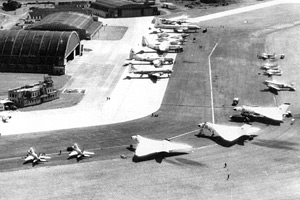Avro Vulcan - History
The Vulcan was designed in response to a specification issued in 1947; a four engined nuclear bomber was required as the growing menace of the Soviet Union made itself felt. Avro's chief designer, Roy Chadwick immediately began an unusual design based on a delta wing concept and a matter of months later, the design had been submitted and had won the contest (along with Handley Page's HP.80 design - later to become the Victor). The design was changed before the familiar Vulcan layout was settled on; fins on the wingtips became a single conventional fin, and the nose was extended along with the addition of a distinct fuselage section as opposed to the near-flying-wing idea originally envisaged. Tragically, Chadwick was killed in an air accident later in the year, but Stuart Davies, his assistant, survived the crash and continued development on the Avro Type 698 design, taking over as head of Avro's design team.
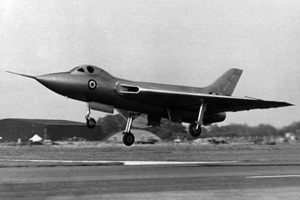
Avro 707C WZ744; via Bill Bielauskas
To help gain data for the radical new design, several 'mini-Vulcans' were built; these were the Avro Type 707s. At one point the RAF wanted a twin-seat 707 for use as a Vulcan trainer, but eventually this requirement was dropped and only one such 707, the 707C, was built. Finally, in 1952, the first prototype of what would become the Vulcan (Type 698 VX770), was ready to fly. This was recognisably a Vulcan, but the wings were of a pure delta form with none of the now-familiar kinked leading edges, and there were several other detail differences in the aircraft's overall shape. Aircraft development in the 1950s was very different to modern-day development - whereas nowadays it seems most time and effort is put into complex computer simulations and making sure the flight control software is working before risking a first flight, in the days of the Vulcan's development, rather more primitive methods were used.
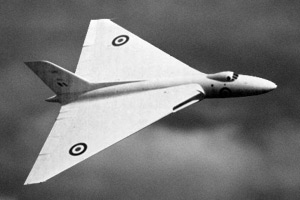
Type 698 VX770 at the 1952 Farnborough SBAC show; Flight
For instance, before the advent of appropriate recording systems, cockpit instruments were filmed with cine cameras and the films were then read by a team of film-readers and transcribed to tabular form. These tables were then plotted on graph paper by any handy apprentices! During a series of tests of emergency braking systems which involved large rubber brake pads carried between the main bogie wheels and extended to contact the runway, the company photographer, Paul Culerne, was actually strapped to the front undercarriage leg to photograph the operation of the pads (no videos in those days!). This was while the aircraft was moving at landing speed - not when stationary!
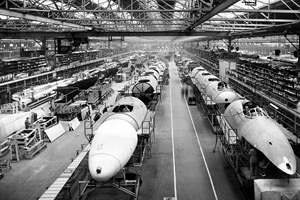
Vulcan production in full swing, 1957; via Garry Lakin
Piloted by Wing Commander Roly Falk, VX770 first flew on 30th August 1952 and, watched only by Avro employees and a small band of press, he showed just why he had fought for a fighter- style joystick instead of the traditional yoke. The first flight did not go entirely to plan - two objects were seen to detach from the aircraft and float to the ground. These turned out to be the triangular undercarriage doors attached to the rear of the main gear legs, and the aircraft flew without them for a short time afterwards. In 1953 the Type 698 was officially named the Vulcan, and surely there can not have been a more fitting appellation given to any aircraft? Several spectacular Farnborough appearances followed, including a full roll at the 1955 show (try that in a B-52!). Falk had actually rolled the Vulcan on returning to Avro's Woodford base after a previous Farnborough appearance - that time he did it so low and so noisily that he smashed all the skylight windows in the assembly building!
The prototype had first flown with Avon engines, as the Rolls-Royce BE.10s (later named Olympus) being developed were not yet ready; it was soon fitted with Armstrong-Siddeley Sapphires instead but only with the fitment of the Olympus was the aircraft's true potential realised. By August 1953, the second prototype, also fitted with the Olympus, was in the air also. Unfortunately, at higher speeds, the wing was suffering from buffeting during manouevres, and the problem was serious enough to require a partial re-design. The production B.1 gained a kinked and dropped leading edge, and a lengthened nose to accomodate extra fuel and simplify the nose gear leg retraction system. Delivery of production B.1s began in 1956 and the first squadron (83 Squadron) formed in May 1957 - but by this time the RAF already had a wary eye on the ever-increasing sophistication of the Soviet Union's defences.
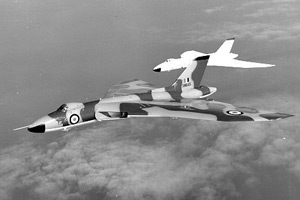
A pair of Vulcan B.2s showing off the new low level camouflage scheme (XM645 in foreground) and the original overall white anti-flash scheme; Crown Copyright via Paul Hartley
The 1957 Defence White Paper spelled an end for many defence projects in the UK, reorganising the UK's defences to support the nuclear deterrent force. With the Vulcan as the tip of the nuclear spear, improving the B.1 was high on the agenda. More powerful engines, an electronic warfare (ECM) suite in a new larger tailcone, in-flight refuelling capability, an improved electrical system and further improved and larger wings formed the basis of a new variant - the B.2 (some B.1s had some B.2 improvements made to them, then being called B.1As). With longer range, the ability to carry a heavier payload and much improved self-defence measures in a vastly more powerful ECM suite, the B.2 made sure that missions into the Soviet Union wouldn't be the suicide mission they would have been with the B.1 - particularly when the switch was mode to low level penetration of enemy airspace. The fatigue life of all V-force aircraft would be reduced by low level operations, but the chances of radar detection were much lower, and with the application of camouflage the chances of visual acquisition from above were also minimised.
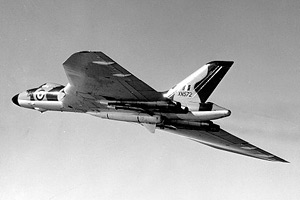
Vulcan B.2 XM572 carrying Blue Steel; Crown Copyright
The nuclear capability of the B.2 was also improved compared to the B.1. Two nuclear weapons (Yellow Sun and Red Beard) could be carried. Even with the B.2's improvements, however, the delivery of free-fall nuclear weapons into the increasingly deadly defences of the Soviet Union was becoming far too dangerous a proposition. Intermediate range Thor missiles became a significant part of the UK's nuclear deterrent, but the flexibility of a manned bomber force was still important. The obvious way to improve the survivability of the V-force was to use stand-off missiles and accordingly Blue Steel was developed. This could be fired up to 100 miles away from the target. As on the Victor, Blue Steels were carried in a partially-recessed manner. The bomb bay area was modified accordingly and the lower tailfin of the missile would be folded over on the ground to give enough ground clearance. On launching the fin would fold down, the missile's rocket engines would fire, boosting it to high altitude and the Vulcan crew would turn for home, leaving Blue Steel to fly on towards the target independently. An improvement over the Blue Steel would have been the American's Skybolt missile, which was intended for use by B-52s and Vulcans. Vulcans would have been able to carry two, one under each wing, and many B.2s were built with suitable attachment points under their wings. However, the programme was a troubled one and despite it looking like becoming a success towards the end, the Americans cancelled it late on in development at the end of 1962.
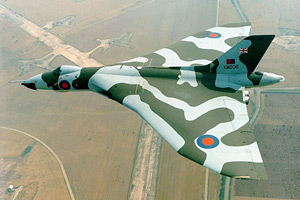
Vulcan B.2 XM606 flying over the former Thor missile base of RAF Ludford Magna; via Paul Hartley
In common with most British aircraft, a number of unusual proposals were made during the Vulcan's life, none of which came to anything. These include an airliner version (the Avro Atlantic), a fighter-support Vulcan which would have carried three Gnats semi-recessed in the fuselage and wings and even a vertical take-off Vulcan (complete with no less than ten lift engines in the bomb bay). Even the least ambitious proposal, the 'Phase 6' Vulcan, which would have had larger wings and tail and an extended fuselage housing a second crew (for very long missions) along with provision for extra bombs in pods on the wings, came to naught, not least because the Americans cancelled the troubled Skybolt nuclear missile that was to have been carried by the Phase 6 Vulcan (and indeed many B.2s).
The loss of Skybolt and the retirement of the obsolete Thor missile meant that the RAF was fielding a nuclear deterrent bomber force that was increasingly outmoded. With the arrival of Polaris ICBMs and associated submarines, the Royal Navy took over the RAF's nuclear deterrent role. Thus, the Vulcan would have flown for its entire service life without ever dropping a bomb in anger - had it not been for the Falklands war in 1982. While of limited tactical use, a succession of Vulcan bombing missions against the Argentine occupiers on the Falklands Islands proved that the UK still had a strategic bomber force to be reckoned with. While damage to Argentine ground forces was limited, the psychological effect was significant and the Argentines kept back a large portion of their air defence fighters to defend against attacks on their mainland.
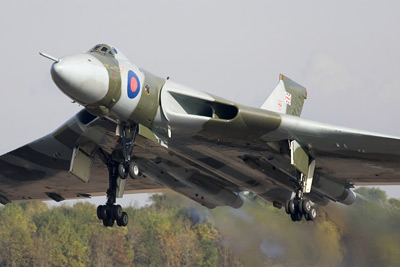
Vulcan XH558 returns to the air in 2007; author
The huge amount of tanker support required by the missions also resulted in the final version of the Vulcan - the K.2 tanker. Requested by the MoD during the Falklands war, a mere 51 days passed between request and delivery of the first K.2. The K.2 was basically a B.2 with an ugly box tacked underneath the tailcone (containing the drogue unit; hoses and drum unit were held within the ECM bay within the tailcone) and the bomb bay was filled with three huge fuel tanks. Huge white areas painted underneath the wings to help receiving aircraft line up on the tanker added their own final uglification. Two years after the Falklands War, in March 1984, the last Vulcan squadron was disbanded, leaving only the Vulcan Display Team to fly on. XL426 thrilled airshow visitors, until 1986 when it was offered for tender. Bought by Roy Jacobsen, now XL426 is now looked after at Southend airport by the Vulcan Restoration Trust. The sale of XL426 did not mean the end of the Vulcan Display Team though - it was replaced by XH558, which was to roar through the skies for many years, becoming the most famous Vulcan of all.
Many Vulcans ended up being scrapped, or burned as fire practice airframes. A few were thankfully preserved and sold to museums or private individuals. Unfortunately defence cuts began to bite into all of the UK's armed forces, and maintaining a single aircraft for display purposes could no longer be justified by the MoD's bean-counters. In early 1993, despite intensive public lobbying to keep her flying, XH558 was finally also offered for tender, retired from the RAF and sold to David Walton who looked after it for some years at Bruntingthorpe airfield in Leicestershire before selling it on to a company formed with the aim of returning her to the air. On 18th October 2007, they had managed just that - the story continues here.
Leading Particulars
| Variant | Type 698 | B.1 | B.1A | B.2 | B.2A | SR.2/B.2MRR | K.2/B.2K |
|---|---|---|---|---|---|---|---|
| First flight | 30th Aug 1952 | 4th Feb 1955 | ? | 19th Aug 1958 | ? | ? | 18th Jun 1982 |
| Crew | Two | Five - pilot, copilot, tactical navigator, radar operator and air electronics officer. | |||||
| Armament | None | Blue Danube or Yellow Sun nuclear bombs, twenty-one 1,000lb bombs | Blue Steel nuclear missile (semi-recessed in internal bomb bay), twenty-one 1,000lb bombs, four AGM-45 Shrike anti-radiation missiles (on wing hardpoints) | None; bomb bay filled with extra fuel tanks | |||
| Powerplant | 4 RR Avon, later Conway, then Olympus | 4 Bristol-Siddeley Olympus 101 (11,000 lb), 102 (12,000 lb) or 104s (13,500 lb) | 4 Bristol-Siddeley Olympus 201 (17,000 lb) or 301s (20,000 lb) distributed evenly through the production run. All B.2As had 201s however. | ||||
| Max. speed | ? | 625 mph (1,006 km/h), 541 kt or Mach 0.92 at 36,000 ft | 645 mph (1,038 km/h) | ||||
| Service ceiling | ? | 55,000 ft (16,764 m) | 65,000 ft (19,812 m) | ||||
| Range | ? | 3,910 miles (7,240 km) | 4,600 miles (7,400 km) | ||||
| Empty weight | ? | ? | ? | ||||
| Max. take off weight | ? | 190,000 lb (86,184 kg) | 204,000 lb (92,534 kg) | ||||
| Wing span | ? | 99 ft (30.17 m) | 111 ft (33.83 m) | ||||
| Wing area | ? | 3,554 sq ft (330.1 sq m) | 3965 sq ft (368.3 sq m) | ||||
| Length | ? | 97 ft 1 in (29.58 m) | 99 ft 11 in (30.45 m) or 105 ft 11 in if refuelling probe fitted | ||||
| Height | ? | 26 ft 6 in (8.08 m) | 27 ft 2 in (8.28 m) | ||||
| Production (total 136*) | 2 | 45 | 28 (all B.1 conversions) | 63* | 26 | 8 (all conversions from B.2) | 6 (all conversions from B.2) |
* Minimum figure. It is thought that several static fatigue test aircraft were built and destroyed.

